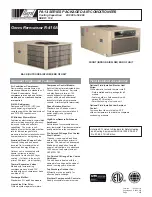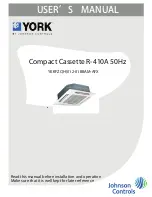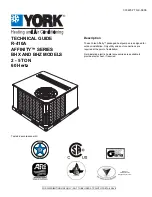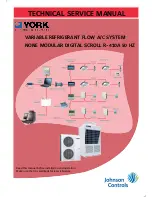
Trouble
s
hooting
s
upport
Ĉ
·
The failure mode detected on the indoor unit side is displayed by
blinking the "timer lamp". And a failure detected on the outdoor
·
If the outdoor unit side detects a failure, the product will first
conduct several operation retrials.
There are some failure modes with no lamp display while retrials
are continued.
[Failure mode where retrials are continued and the indoor unit lamp
does not end up giving a display]
ǂ
OH thermistor heat-up
ǂ
Overload lower limit cut
ǂ
Low-frequency things
·
The failure modes detected on the indoor and outdoor unit sides
are stored in the nonvolatile memory of the indoor unit and can be
read later on.
ǂ
(The memory will remain even after power-off.)
·
The failure modes detected on the outdoor unit side are written in
memory every time any such mode occurs. The failure mode can
therefore be detected on the indoor unit side without waiting for
the retry frequency to reach the display of the indoor unit lamp.
Moreover, the normal self-diagnosis display function which rarely
occurs will store and display failure modes that do not end up
displaying the indoor unit lamp.
ǂ
(Any such mode may be unable to be stored if indoor or outdoor
communications is in a failure.)
·
The product stores 5 last-stored failure modes.
·
There is a function for deleting memory. Once you clear the
memory and run the product for several days, you can read the
failure modes and check them, thereby detecting the less
frequent failure phenomena.
·
Failure modes can be checked by both the blinking of the lamp of
the indoor unit and the display of the remote control liquid crystal
display.
·
The failure mode detected on the outdoor unit side is displayed by
ǂ
blinking the "LD301". Detecting a failure will stop the outdoor unit
ǂ
and keep blinking the LD301 until it is restarted.
ǂ
(The communication error will persist until the communication is
ǂ
reestablished.)
Ć
The "self-diagnosis function of the communication circuit" available in our conventional models is now incorporated
as part of the normal self-diagnosis function. In the case of a failure in the communication circuit, you do not have
to conduct a special operation and the operations can be automatically divided into 3 blinking operations and 12
blinking operations of the timer lamp. However, a strong external noise may have resulted in 12 times of blinking.
Function
n
o
i
t
p
i
r
c
s
e
D
Self-diagnosis display
[Display on the indoor
unit side]
[Display on the
outdoor unit side]
Self-diagnosis memory
unit side will be indicated by the "time lamp" blinking 4 times.
- 66 -
Содержание RAK-18QXB
Страница 2: ... DANGER 2 ...
Страница 24: ... 24 ...
Страница 25: ... 25 ...
Страница 26: ... 26 ...
Страница 27: ... 27 ...
Страница 28: ... 28 ...
Страница 31: ...WIRING DIAGRAM RAK 18QXB RAK 25RXB RAK 35RXB RAK 50RXB 31 ...
Страница 32: ...WIRING DIAGRAM OF THE PRINTED WIRING BOARD Remote controller RAR 6N1 SWB SW10 Carbon SW Reset carbon SW 32 ...
Страница 33: ...CIRCUIT DIAGRAM MODEL RAK 18QXB POWER FOR CLEANNESS 33 ...
Страница 34: ...CIRCUIT DIAGRAM MODEL RAK 25RXB RAK 35RXB RAK 50RXB POWER FOR CLEANNESS 34 ...
Страница 57: ...10 10 10 10 10 R901 R904 R641 R907 R908 R694 R902 R695 R741 R740 R642 DSW1 DSW1 R903 R905 R906 57 ...
Страница 68: ...69 68 ...
Страница 71: ...3 and page 38 7 71 ...
Страница 72: ...Please set the DIP switch No 6 to ON accordingly Refe to page r 57 RAR 6N1 RAR 6N2 RAR 6N3 RAR 6N4 RAR 6N5 72 ...
Страница 73: ...57 73 ...
Страница 74: ... 74 ...
Страница 92: ...RAK 18QXB RAK 25RxXB HHAW NO 0088E 1 RAK 35RXB RAK 50RXB 92 ...















































